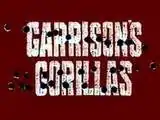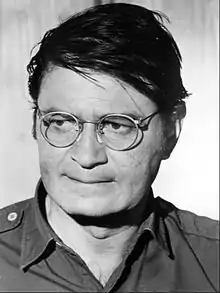| Garrison's Gorillas | |
|---|---|
 Opening Screen for Garrison's Gorillas | |
| Created by | Mort Green |
| Starring | Ron Harper as First Lt. Craig Garrison Cesare Danova as Actor Brendon Boone as Chief Rudy Solari as Casino Christopher Cary as Goniff |
| Country of origin | United States |
| No. of episodes | 26 |
| Production | |
| Running time | 60 minutes |
| Production company | Selmur Productions |
| Original release | |
| Network | ABC |
| Release | September 5, 1967 – March 12, 1968 |
Garrison's Gorillas is an ABC TV series originally broadcast from 1967 to 1968; a total of 26 hour-long episodes were produced. It was inspired by the 1967 film The Dirty Dozen, which featured a similar scenario of training Allied prisoners for World War II military missions.
Garrison's Gorillas was canceled at the close of its first season and replaced by The Mod Squad in 1968. It managed to gather a cult following in China in the 1980s.[1]

Plot
This action series focused on a group of commandos recruited from stateside prisons to use their special skills against the Germans in World War II. They had been promised a parole at the end of the war if they worked out (and if they lived). The alternative was an immediate return to prison; if they ran, they could expect execution for desertion. The four were: "Actor" (Cesare' Danova), a handsome, resonant-voiced con man; "Casino" (Rudy Solari), a tough, wiry safe-cracker and mechanic; "Goniff" (Christopher Cary), a slender, likable cat burglar; and "Chief" (Brendon Boone), a rugged, somber American Indian who handled a switchblade like he was born to it. No real names were ever used, only their "monikers" or aliases. Led by West Pointer First Lt. Craig Garrison (Ron Harper) and headquartered in a secluded mansion in London, this slippery group ranged all over Europe in exploits that often took them behind enemy lines. Other recruits were sometimes brought in where special skills were required. In the episode "Banker's Hours", Jack Klugman's character is recruited to help loot a vault. In "The Magnificent Forger", comedian Larry Storch plays a con brought in to help 'doctor' a Gestapo list of American agents. And in the two-parter "War And Crime/Plot to Kill", a con played by Richard Kiley is recruited because he is a dead ringer for a German field marshal who was part of a plot to assassinate Hitler. The episodes are set in 1941, 1942, 1943 and 1944.
Cast
- Ron Harper as Lt. Craig "Warden" Garrison
- Cesare Danova as Actor
- Brendon Boone as Chief
- Rudy Solari as Casino
- Christopher Cary as Goniff
Episodes
| No. | Title | Directed by | Written by | Original air date |
|---|---|---|---|---|
| 1 | "The Big Con" | Joseph Sargent | David Karp | September 5, 1967 |
| 2 | "Breakout" | Michael Caffey | Paul Playdon | September 12, 1967 |
| 3 | "The Grab" | Nicholas Colasanto | James Menizes | September 19, 1967 |
| 4 | "Banker's Hours" | Georg Fenady | Tony Barrett | September 26, 1967 |
| 5 | "48 Hours to Doomsday" | Gerald Mayer | Jerry Thomas, Bill Yagemann | October 3, 1967 |
| 6 | "The Great Theft" | Michael Caffey | Norman Hudis | October 10, 1967 |
| 7 | "The Deadly Masquerade" | Nicholas Colasanto | Alan Caillou | October 17, 1967 |
| 8 | "Now I Lay Me Down to Die" | Georg Fenady | Edward J. Lakso | October 24, 1967 |
| 9 | "Operation Hellfire" | Michael Caffey | Jerry Thomas, Bill Yagemann | October 31, 1967 |
| 10 | "Thieves' Holiday" | John Peyser | James Menizes | November 7, 1967 |
| 11 | "20 Gallons to Kill" | Nicholas Colasanto | Barry Trivers | November 14, 1967 |
| 12 | "Friendly Enemies" | Michael Caffey | Edward J. Lasko | November 21, 1967 |
| 13 | "Black Market" | Georg Fenady | Tony Barrett | November 28, 1967 |
| 14 | "The Great Crime Wave" | Nicholas Colasanto | Norman Hudis | December 5, 1967 |
| 15 | "The Magnificent Forger" | Georg Fenady | William R. Yates | December 19, 1967 |
| 16 | "The Expendables" | Georg Fenady | Paul Playdon | December 26, 1967 |
| 17 | "War Games" | Michael Caffey | William R. Yates | January 2, 1968 |
| 18 | "Run from Death" | Nicholas Colasanto | Shimon Wincelberg, Richard Shapiro | January 9, 1968 |
| 19 | "The Death Sentence" | John Peyser | Paul Playdon | January 16, 1968 |
| 20 | "The Big Lie" | Georg Fenady | Jerry Thomas, Bill Yagemann | January 23, 1968 |
| 21 | "Ride of Terror" | Alan Crosland | William Froug | January 30, 1968 |
| 22 | "War and Crime: Part 1" | Georg Fenady | S : Tony Barrett; T : William Robert Yates | February 13, 1968 |
| 23 | "The Plot to Kill: Part 2" | Georg Fenady | S : John Draft; T : William Robert Yates | February 20, 1968 |
| 24 | "The Frame-Up" | John Peyser | Henry Slesar | February 27, 1968 |
| 25 | "The War Diamonds" | Michael Caffey | William Robert Yates | March 5, 1968 |
| 26 | "Time Bomb" | Georg Fenady | Paul Playdon | March 12, 1968 |
Reviews


TV Guide reviewer Cleveland Amory said of the show in 1968 that, despite it being ludicrously one-sided, a second-hand idea, and third degree violence, that it was a first-rate show.[2]
Because it was one of the first U.S. television shows exported to China, Garrison's Gorillas (《加里森敢死队》 Jiālǐ sēn gǎnsǐduì, or "Garrison's Death Squad") developed a certain cult status in the 1980s; supposedly, high-level meetings of the Chinese Communist Party were rescheduled so the members could watch the program. Garrison's Gorillas was even awarded a Public Security Award in Shanghai, as many Chinese people (even criminals) stayed home to watch it.[3]
Spin-offs and tie-ins
Dell Comics published a short-lived five issue comic book based on the series lasting from January 1968 to October 1969)
Two spin-off novels were written by Jack Pearl: the first a mass-market adult paperback published by Dell, called, simply Garrison's Gorillas; the second aimed at the young adult (YA) market and published by Whitman, titled Garrison's Gorillas and the Fear Formula. Both are long out of print.
In 1967, Leaf produced a trading card set consisting of 72 black and white photographs from the series.[4]
References
- ↑ Manfred, Kops; Ollig, Steven (2007). Internationalisation of the Chinese TV Sector. Berlin: LIT Verlag Hamburg Berlin Munster. p. 80. ISBN 978-3-8258-0753-5.
- ↑ Altschuler, Gleen C.; David I. Grossvogel (1992). Changing Channels: America in TV Guide. University of Illinois Press. p. 56. ISBN 978-0-252-01779-7.
- ↑ "The World of Chinese | How People Live in Contemporary China".
- ↑ http://www1.coe.neu.edu/~dan/R734-9/go.html
External links
- "Garrison's Gorillas Fan Site". Archived from the original on 2012-05-03. Retrieved 16 January 2014.
- "Garrison's Gorillas Headquarters". Retrieved 16 January 2014.
- Complete Garrison's Gorillas Episode Guide
- Garrison's Gorillas at IMDb